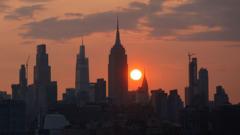The wildfires have already displaced tens of thousands of residents in Canada, exacerbating air quality concerns throughout the northern United States. Saturday's Air Quality Index (AQI) is expected to surpass 100 in large parts of New York state and could peak at 135, signaling significant health risks, particularly for sensitive populations. Alerts are also being issued across parts of New England as the smoke proliferates.
The AQI serves as a crucial measure of air pollution severity and related health risks; higher numbers indicate poorer air quality conditions. U.S. authorities had previously issued similar alerts due to Canadian wildfire smoke, such as one in mid-July for Chicago, which came with advisories particularly aimed at vulnerable groups like infants and the elderly.
The political ramifications of the wildfire situation have also reached Washington, D.C. In a recent communication, six U.S. Congress members formally expressed their dissatisfaction to the Canadian ambassador, citing the ongoing smoke from Canadian wildfires as a major impediment to enjoying summer leisure activities in the United States.
Current reports indicate that there are over 550 active wildfires raging across Canada, particularly in Manitoba, with an astounding 6.1 million hectares (approximately 15 million acres) having burned in the last year alone. The months of May and June were particularly harrowing, prompting around 30,000 residents in Saskatchewan and Manitoba to evacuate as local governments declared states of emergency.
Scientists have consistently linked the escalation of wildfire seasons to climate change, highlighting that Canada is warming at a rate estimated to be twice the global average, with its Arctic areas experiencing an even more rapid increase in temperature, nearing three times the average.
The AQI serves as a crucial measure of air pollution severity and related health risks; higher numbers indicate poorer air quality conditions. U.S. authorities had previously issued similar alerts due to Canadian wildfire smoke, such as one in mid-July for Chicago, which came with advisories particularly aimed at vulnerable groups like infants and the elderly.
The political ramifications of the wildfire situation have also reached Washington, D.C. In a recent communication, six U.S. Congress members formally expressed their dissatisfaction to the Canadian ambassador, citing the ongoing smoke from Canadian wildfires as a major impediment to enjoying summer leisure activities in the United States.
Current reports indicate that there are over 550 active wildfires raging across Canada, particularly in Manitoba, with an astounding 6.1 million hectares (approximately 15 million acres) having burned in the last year alone. The months of May and June were particularly harrowing, prompting around 30,000 residents in Saskatchewan and Manitoba to evacuate as local governments declared states of emergency.
Scientists have consistently linked the escalation of wildfire seasons to climate change, highlighting that Canada is warming at a rate estimated to be twice the global average, with its Arctic areas experiencing an even more rapid increase in temperature, nearing three times the average.


















